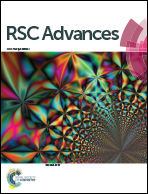3D porous hybrids of defect-rich MoS2/graphene nanosheets with excellent electrochemical performance as anode materials for lithium ion batteries†
Abstract
In recent years, the global energy crisis and environmental concerns have put forward an ever-growing demand for efficient energy storage, which has accelerated the development of lithium ion batteries with higher power density and longer cycle life. Herein, we demonstrate a facile and scalable process to prepare three-dimensional (3D) porous hybrids comprised of ultrathin defect-rich MoS2 nanosheets (dr-MoS2 NSs) and conductive graphene nanosheets (GNS) via a hydrothermal co-assembly process. The resulting dr-MoS2/graphene (dr-MoS2/GNS) hybrids possess a 3D porous structure with large specific surface area, which enables rapid diffusion of lithium ions to access active materials. The ultrathin dr-MoS2 NSs with exposure of additional active edge sites significantly facilitate the intercalation of lithium ions, thus leading to higher specific capacity. The interconnected graphene network not only provides highly conductive pathways facilitating the charge transfer and lithium ion transport, but also maintains its structural stability during the lithiation/delithiation process. As a consequence, the dr-MoS2/GNS (6 : 1) hybrid exhibits a high reversible capacity of 1130.9 mA h g−1 at a current density of 0.1 A g−1, with excellent cyclic stability and rate capability. The outstanding electrochemical performance of the dr-MoS2/GNS hybrids can be ascribed to their 3D porous structure and the synergetic effect between ultrathin dr-MoS2 NSs and the conductive graphene network, making them promising anode materials for high performance lithium ion batteries.


 Please wait while we load your content...
Please wait while we load your content...